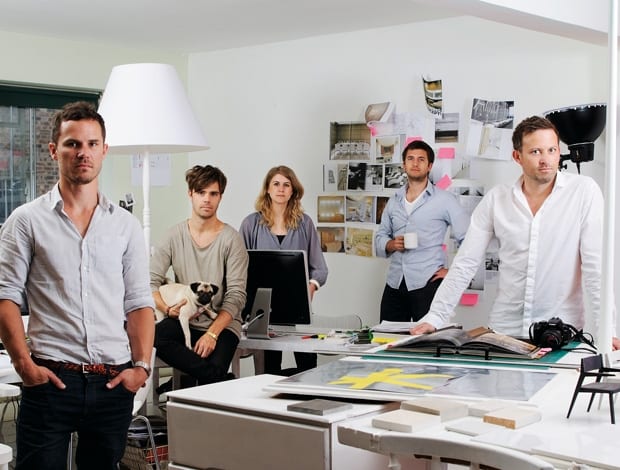 Campaign staff, from left to right: Aaron Richardson, head of graphics; Neil Sharman (with Effie the pug), head of interiors; Lena Kramer, interior architect; Benedict Wilhelm, interior architect Philip Handford, creative director|Campaign’s design for Dr Martens’ pop-up store plays on the concept of customers entering into the back-of-house stock room|The Alchemy Table, the self-comissioned, somewhat homespun piece of furniture that provides Campaign’s main desk spac||
Campaign staff, from left to right: Aaron Richardson, head of graphics; Neil Sharman (with Effie the pug), head of interiors; Lena Kramer, interior architect; Benedict Wilhelm, interior architect Philip Handford, creative director|Campaign’s design for Dr Martens’ pop-up store plays on the concept of customers entering into the back-of-house stock room|The Alchemy Table, the self-comissioned, somewhat homespun piece of furniture that provides Campaign’s main desk spac||
Low overheads have led to creative highs for design workshop Campaign
If you spy a spray-painted pigeon or a shrink-wrapped bicycle around Brick Lane or Spitalfields during the London Design Festival, it may well be a curio by design workshop Campaign. Follow the low-key trail of objects, and you’ll stumble on its studio, inconspicuous among the otherwise dusty, historic doors of Princelet Street, just off Brick Lane.
Campaign was set up to push the boundaries of the consumer experience through new methods and media. Its office, which opens its doors (and its roof garden) during the festival, tells its own unique and engaging brand story. The whitewashed floor, laid over the original floorboards of the split-level converted apartment, cost £3.50/m – the cheapest laminate on the market.
The desk from which they all work, known as the Alchemy Table, is made from whitewashed recycled furniture – doors, desks, bureaus and tables, fused together to form one collaborative work surface meandering through the open-plan space: “This is the table which I started the company from,” says creative director Philip Handford.
The desks of Neil Sharman, head of interiors, and Aaron Richardson, head of graphics, are locked onto it, with a backwards-facing chair welded on as an impromptu perch point.
Daniel Wang, a graduate in animated architecture from The Bartlett School of Architecture, and the most recent addition to the team, is furthest away, using a welded-on, discarded executive desk surface, acquired from a reclaimed furniture depot under the old railway arches a stone’s throw away. A fixed lamp protrudes upward from the table, and extra legs and balustrades support the irregular construct.
“We self-commissioned the project on a budget of nothing, and created a poetic idea out of something cost effective; it was a perfect first project,” Handford explains.
Behind the desk, a circular table is where meetings take place, and a back wall plastered with print-outs is a space for collaborating on ideas. A second-hand wardrobe supports a newly acquired projector, to introduce new media to meetings and presentations.
Behind this Handford’s wife runs a business from a constructed wooden and glass ‘box’ office on castors, and beyond this is their living space. “It’s intense living and working in the same space,” says Handford, “but at the moment I enjoy that intensity.” To add to the quasi-domesticity of the space, Effie, a nine-month-old pug belonging to Neil Sharman pads affably around the place.
Handford’s background is in retail design, a specialism that demands “a depth of thought, time and effort in looking at a subject, and how you design space around it.” Having previously worked at Imagination, Virgile & Stone and BarberOsgerby, he’s designed commercial environments for a host of international clients.
Campaign is currently collaborating with Christopher Bailey, creative director of Burberry, on a comprehensive series of furniture ranges forBurberry new global headquarters in London, as well as the American headquarters in New York and some new store concepts. It is also currently working on print work for the University of Arts London and the branding for a teenage fashion brand; lined up is a restaurant interior and a spa on the Kings Road.
“We’re looking forward to working on interiors, from offices to hairdressers,” says Handford.
Right now, though, it’s all hands on deck with the pop-up store in the centre of Spitalfields market that Campaign has designed for the festival for Dr Martens. Observing it during the ‘popping’ process, light bulbs hang from telephone cords, transparent luminous yellow warehouse curtaining hangs down around a central space, Gypframe metal cages lie ready to display boots, and a team industriously polish away at the glass shell. The test samples on the floor of Campaign’s office strongly suggest stencils and spray paint will be a final finishing feature.
“We’re looking forward to working on interiors, from offices to hairdressers”
“Working with creative brand managers Fresh, we had to change the space on a minimal budget in a minimal time frame,” says Handford. “The story behind the store is ‘warehouse’ – instead of walking into a shop you are entering Dr Martens’ backroom, a space that’s usually off-limits.”
It’s a utilitarian aesthetic that uses a readily available palette of materials in a creative and slightly guerilla way. And like Campaign’s office space, it is a resourceful, economical and engaging space, an aesthetic that looks set to thrive, especially as corporates seek out smaller consultants whose work ethos tends to place vision over overheads.
Handford set up Campaign in January at a difficult time when the recession was biting hard. The studio was set up “in a low key, low overhead kind of way”.
Almost everything in the new workplace has been acquired from the smattering of second-hand dealers and reclaimed furniture yards that populate this patch of east London. It’s an approach that has helped them to get up and running quickly, and business it seems, has followed suit.























